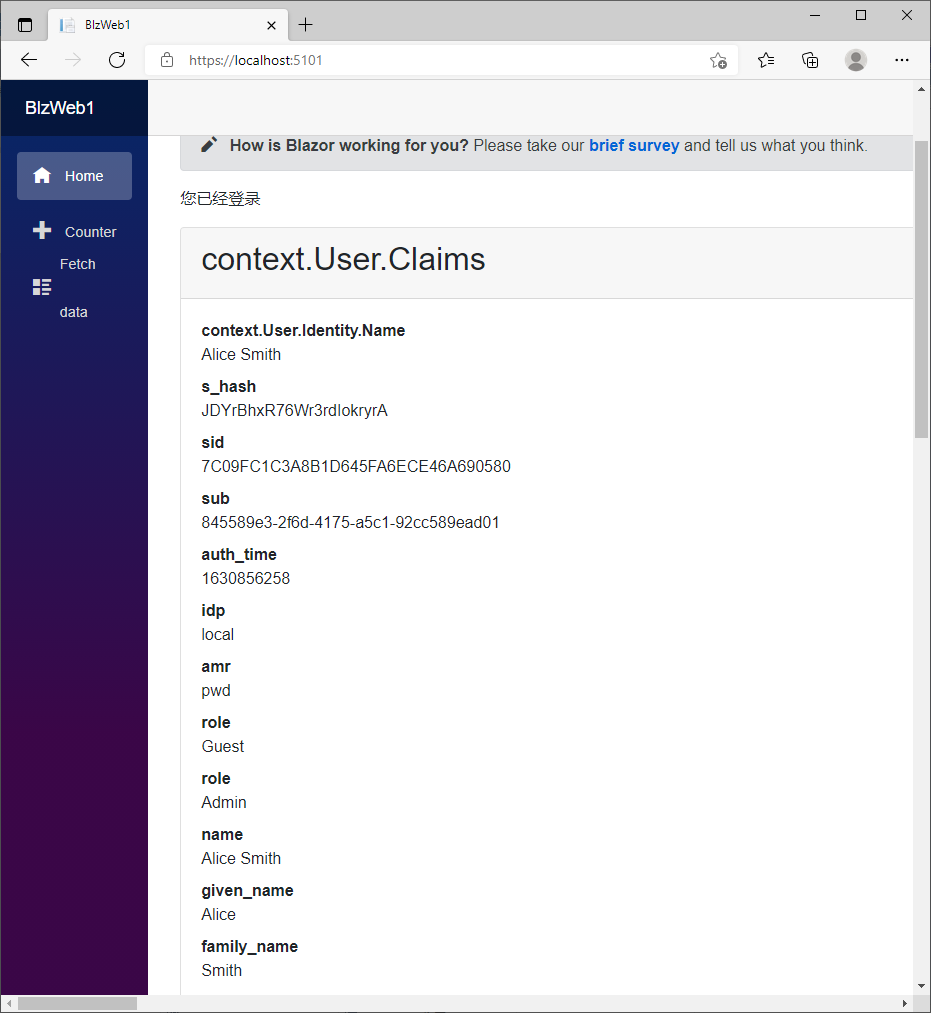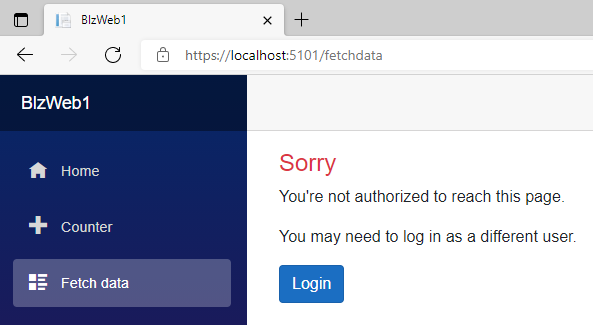Blazor Server访问Identity Server 4单点登录2-集成Asp.Net角色
采用内存用户集合的模板创建的项目,是不能用于生产环境的,毕竟用户信息只存在于内存。Id4有一个模板是可以采用Asp.Net内置的用户数据库的,直接创建这个模板的项目即可。
创建AspNet用户数据库的Identity Server 4项目
在控制台进入解决方案目录,创建is4aspid模板项目。
D:\Software\gitee\blzid4\BlzId4Web>dotnet new is4aspid -n AspNetId4Web
已成功创建模板“IdentityServer4 with ASP.NET Core Identity”。
正在处理创建后操作...
模板配置为运行以下操作:
说明:
手动说明: Seeds the initial user database
实际命令: dotnet run /seed
是否要运行此操作 [Y(是)|N(否)]?
y
正在运行命令:“dotnet run /seed”...
命令已成功。
参考前文《Blazor Server访问Identity Server 4单点登录》
https://www.cnblogs.com/sunnytrudeau/p/15145388.html
Config.cs新增2个客户端定义
new Client()
{
ClientId="BlazorServer1",
ClientName = "BlazorServer1",
ClientSecrets=new []{new Secret("BlazorServer1.Secret".Sha256())},
AllowedGrantTypes = GrantTypes.Code,
AllowedCorsOrigins = { "https://localhost:5101" },
RedirectUris = { "https://localhost:5101/signin-oidc" },
PostLogoutRedirectUris = { "https://localhost:5101/signout-callback-oidc" },
AllowedScopes = { "openid", "profile", "scope1" }
},
new Client()
{
ClientId="BlazorServer2",
ClientName = "BlazorServer2",
ClientSecrets=new []{new Secret("BlazorServer2.Secret".Sha256())},
AllowedGrantTypes = GrantTypes.Code,
AllowedCorsOrigins = { "https://localhost:5201" },
RedirectUris = { "https://localhost:5201/signin-oidc" },
PostLogoutRedirectUris = { "https://localhost:5201/signout-callback-oidc" },
AllowedScopes = { "openid", "profile", "scope1" }
},
创建Blazor Server项目
参考前文《Blazor Server访问Identity Server 4单点登录》,创见2个Blazor Server客户端项目。
然后运行3个项目,测试验证id4单点登录。
增加角色
Asp.Net项目最常见的授权策略就是基于角色,默认创建的Identity Server 4项目是没有角色的,得手工加上。这个还相当麻烦。
首先要给用户增加角色,在SeedData增加函数AddRole。
/// <summary>
/// 给测试用户增加角色
/// </summary>
/// <param name="serviceProvider"></param>
public static void AddRole(IServiceProvider serviceProvider)
{
using var scope = serviceProvider.CreateScope();
using var roleManager = scope.ServiceProvider.GetRequiredService<RoleManager<IdentityRole>>();
using var userMgr = scope.ServiceProvider.GetRequiredService<UserManager<ApplicationUser>>();
bool roleExists = roleManager.RoleExistsAsync("Admin").Result;
if (!roleExists)
{
var result = roleManager.CreateAsync(new IdentityRole("Admin"));
}
roleExists = roleManager.RoleExistsAsync("Guest").Result;
if (!roleExists)
{
var result = roleManager.CreateAsync(new IdentityRole("Guest"));
}
var alice = userMgr.FindByNameAsync("alice").Result;
if (alice != null)
{
var roles = userMgr.GetRolesAsync(alice).Result;
if (!roles.Contains("Admin"))
{
var result = userMgr.AddToRoleAsync(alice, "Admin");
}
if (!roles.Contains("Guest"))
{
var result = userMgr.AddToRoleAsync(alice, "Guest");
}
}
var bob = userMgr.FindByNameAsync("bob").Result;
if (bob != null)
{
var roles = userMgr.GetRolesAsync(bob).Result;
if (!roles.Contains("Guest"))
{
var result = userMgr.AddToRoleAsync(bob, "Guest");
}
}
}
在id4项目初始化阶段检查执行,增加角色。
SeedData.AddRole(host.Services);
id4项目config增加role资源
public static IEnumerable<IdentityResource> IdentityResources =>
new IdentityResource[]
{
new IdentityResources.OpenId(),
new IdentityResources.Profile(),
new IdentityResource("role", new string[]{JwtClaimTypes.Role })
};
客户端配置AllowedScopes也增加role
new Client()
{
ClientId="BlazorServer1",
ClientName = "BlazorServer1",
ClientSecrets=new []{new Secret("BlazorServer1.Secret".Sha256())},
AllowedGrantTypes = GrantTypes.Code,
AllowedCorsOrigins = { "https://localhost:5101" },
RedirectUris = { "https://localhost:5101/signin-oidc" },
PostLogoutRedirectUris = { "https://localhost:5101/signout-callback-oidc" },
//效果等同客户端项目配置options.GetClaimsFromUserInfoEndpoint = true
//AlwaysIncludeUserClaimsInIdToken = true,
AllowedScopes = { "openid", "profile", "scope1", "role", }
},
Blazor Server项目增加获取role的scope,并且在id4用户信息端点拿到role之后要手工解析,因为id4返回的role可能是单个字符串,也可能是字符串数组,Blazor Server不认识。
//默认采用cookie认证方案,添加oidc认证方案
services.AddAuthentication(options =>
{
options.DefaultScheme = "cookies";
options.DefaultChallengeScheme = "oidc";
})
//配置cookie认证
.AddCookie("cookies")
.AddOpenIdConnect("oidc", options =>
{
//id4服务的地址
options.Authority = "https://localhost:5001";
//id4配置的ClientId以及ClientSecrets
options.ClientId = "BlazorServer1";
options.ClientSecret = "BlazorServer1.Secret";
//认证模式
options.ResponseType = "code";
//保存token到本地
options.SaveTokens = true;
//很重要,指定从Identity Server的UserInfo地址来取Claim
//效果等同id4配置AlwaysIncludeUserClaimsInIdToken = true
options.GetClaimsFromUserInfoEndpoint = true;
//指定要取哪些资料(除Profile之外,Profile是默认包含的)
options.Scope.Add("scope1");
options.Scope.Add("role");
//这里是个ClaimType的转换,Identity Server的ClaimType和Blazor中间件使用的名称有区别,需要统一。
//User.Identity.Name=JwtClaimTypes.Name
options.TokenValidationParameters.NameClaimType = "name";
options.TokenValidationParameters.RoleClaimType = "role";
options.Events.OnUserInformationReceived = (context) =>
{
//id4返回的角色是字符串数组或者字符串,blazor server的角色是字符串,需要转换,不然无法获取到角色
ClaimsIdentity claimsId = context.Principal.Identity as ClaimsIdentity;
var roleElement = context.User.RootElement.GetProperty(JwtClaimTypes.Role);
if (roleElement.ValueKind == System.Text.Json.JsonValueKind.Array)
{
var roles = roleElement.EnumerateArray().Select(e => e.ToString());
claimsId.AddClaims(roles.Select(r => new Claim(JwtClaimTypes.Role, r)));
}
else
{
claimsId.AddClaim(new Claim(JwtClaimTypes.Role, roleElement.ToString()));
}
return Task.CompletedTask;
};
});
测试获取角色
同时运行3个项目,在Blazor Server项目主页用alice登录,可以看到正确获取到了role。

在id4控制台信息可以看到,Blazor Server客户端请求用户信息时,返回了role字段。
[23:37:38 Debug] IdentityServer4.Validation.TokenValidator
Token validation success
{"ClientId": null, "ClientName": null, "ValidateLifetime": true, "AccessTokenType": "Jwt", "ExpectedScope": "openid", "TokenHandle": null, "JwtId": "3223AFCB3DB832A92A69A04470AE144F", "Claims": {"nbf": 1630856258, "exp": 1630859858, "iss": "https://localhost:5001", "aud": "https://localhost:5001/resources", "client_id": "BlazorServer1", "sub": "845589e3-2f6d-4175-a5c1-92cc589ead01", "auth_time": 1630856258, "idp": "local", "jti": "3223AFCB3DB832A92A69A04470AE144F", "sid": "7C09FC1C3A8B1D645FA6ECE46A690580", "iat": 1630856258, "scope": ["openid", "profile", "scope1", "role"], "amr": "pwd"}, "$type": "TokenValidationLog"}
[23:37:38 Debug] IdentityServer4.ResponseHandling.UserInfoResponseGenerator
Creating userinfo response
[23:37:38 Debug] IdentityServer4.ResponseHandling.UserInfoResponseGenerator
Scopes in access token: openid profile scope1 role
[23:37:38 Debug] IdentityServer4.ResponseHandling.UserInfoResponseGenerator
Requested claim types: sub name family_name given_name middle_name nickname preferred_username profile picture website gender birthdate zoneinfo locale updated_at role
[23:37:38 Information] IdentityServer4.ResponseHandling.UserInfoResponseGenerator
Profile service returned the following claim types: sub name given_name family_name website role role preferred_username
[23:37:38 Debug] IdentityServer4.Endpoints.UserInfoEndpoint
End userinfo request
测试角色授权
给counter页面增加认证要求,只要登录用户都能访问
@attribute [Authorize]
给FetchData页面增加Admin角色授权要求,只有Admin角色可以访问
@attribute [Authorize(Roles ="Admin")]
用alice登录,两个页面都可以访问,用bob登录,访问counter页面没问题,访问FetchData页面提示没有权限

这样就可以用于真实的产品项目中去了。
DEMO代码地址:https://gitee.com/woodsun/blzid4




 浙公网安备 33010602011771号
浙公网安备 33010602011771号